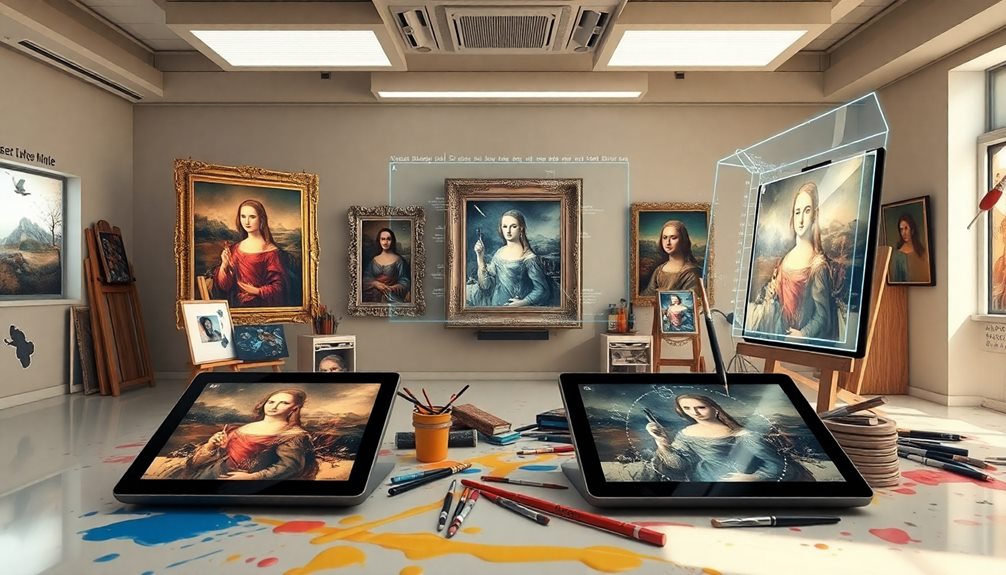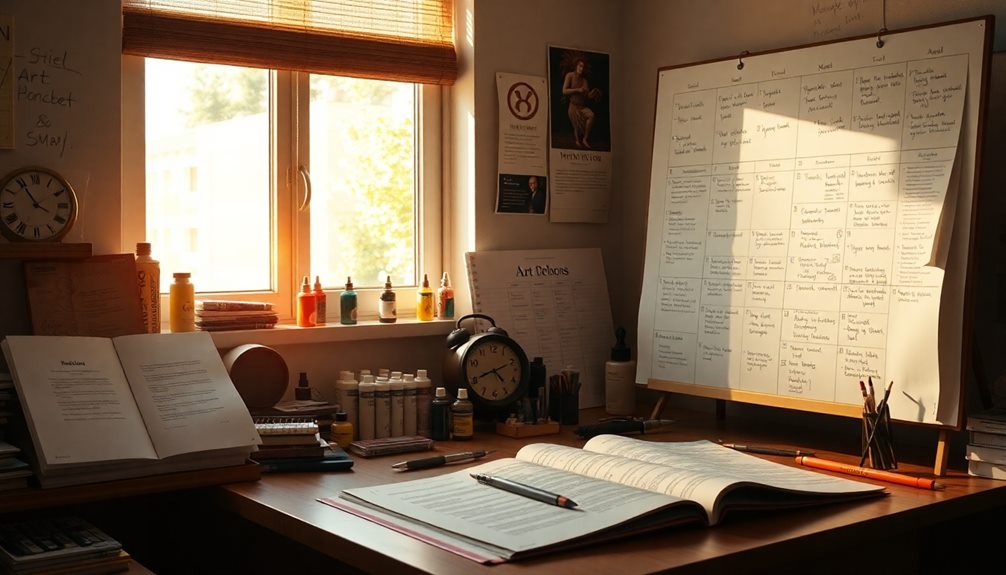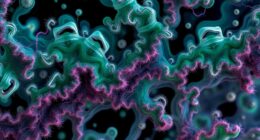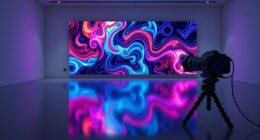Technology tools for art analysis can transform how you engage with and understand artworks. With software like Adobe Photoshop and GIMP, you can uncover hidden details and manipulate images to study visual elements. AI-driven applications help identify artistic styles and provide contextual insights. Digital annotation tools allow for real-time collaboration and critique, enhancing discussion around art. Use platforms like Google Arts & Culture for high-resolution images and interactive museum experiences. These tools open up new avenues for analysis and appreciation. Keep exploring, and you'll discover even more ways to enrich your understanding of art through technology.
Key Takeaways
- Digital annotation tools like Adobe Acrobat enable interactive examinations and collaborative critique of artworks.
- Image editing software such as Photoshop and GIMP allows manipulation of artwork images to reveal hidden textures and colors.
- Art comparison apps like Artivive facilitate side-by-side analysis to enhance understanding of different artistic styles.
- Visual recognition software, including Google Lens, identifies styles and provides contextual insights for deeper art analysis.
- Online platforms like Google Arts & Culture offer high-resolution images and descriptions, enhancing access to art for research and study.
Introduction
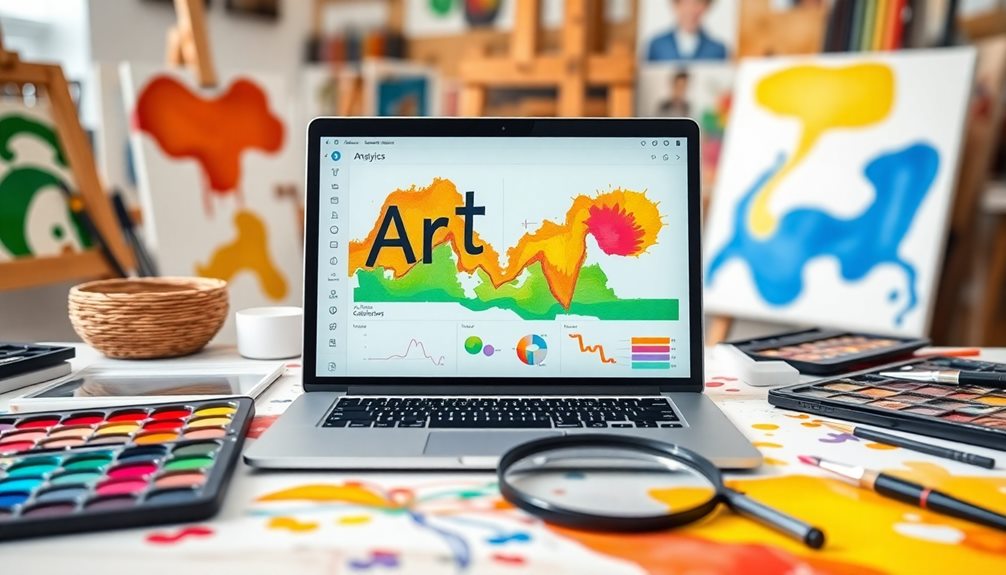
In the realm of art analysis, technology tools have transformed the way we engage with and understand artworks. You can now utilize digital tools like Adobe Photoshop and GIMP to manipulate images, revealing textures, colors, and compositions that might escape the naked eye. This enhanced visibility allows for a deeper appreciation of the artist's creative skills and techniques, especially when analyzing urban landscapes in contemporary Indian painting that often reflect complex socio-political narratives.
AI algorithms, such as those found in Art Recognition Software, enable you to identify styles, artists, and historical contexts of pieces with remarkable precision. These technology tools not only streamline the analysis process but also enrich your understanding of the significance behind each artwork.
Additionally, digital annotation tools foster collaboration among educators and students, allowing you to critique and discuss art pieces in real-time. You can highlight elements, add comments, and share interpretations, creating a dynamic learning environment.
Online resources, like Google Arts & Culture, provide access to high-resolution images and detailed descriptions, making art analysis more accessible than ever.
Key Concepts and Definitions

Understanding key concepts and definitions in art analysis is vital for grasping the intricacies of visual representation. Art analysis involves examining the visual elements, composition, and context of an artwork to uncover its meaning and significance. Key concepts include form, color, line, texture, space, and composition, which collectively shape the aesthetic and emotional impact you perceive.
Additionally, the rise of automation in business has introduced new tools that can streamline the analysis process, enhancing the ability to study artworks in depth.
Moreover, the historical context in which an artwork was created plays a crucial role in its interpretation. Recognizing the artist's intentions and the societal influences of their time can deepen your understanding. Various critical theories, like formalism, feminism, and Marxism, provide frameworks that help you analyze art from different perspectives, revealing its diverse meanings and values.
In today's digital age, technology tools enhance the art analysis process. Digital image analysis software and interactive platforms allow you to perform detailed examinations of artworks, even down to pixel-level details.
These tools broaden access to art, making it easier for you to engage with the creative process and appreciate the nuances of different pieces. Embracing these concepts and tools will enrich your experience of art analysis and deepen your appreciation for visual culture.
Essential Tools for Analysis

When analyzing artwork, having the right tools at your fingertips can significantly enhance your experience. Digital art has transformed how you engage with visual pieces, and various essential tools can help you delve deeper into analysis.
Start with digital annotation tools like Adobe Acrobat and Kami, which let you highlight features and techniques directly on the artwork, facilitating a more interactive examination. Additionally, leveraging technical SEO tools can help ensure your online art portfolio is accessible and performs well, enhancing your visibility in the digital space.
Image editing software, such as Photoshop and GIMP, allows you to manipulate images of artworks. You can adjust contrast, brightness, and color to better understand the artist's choices.
For a more comparative approach, art comparison apps like Artivive and Google Arts & Culture let you view artworks side by side, enriching your analysis of style and composition.
Additionally, visual recognition software like Google Lens can identify art styles and provide contextual insights, enhancing your understanding of the artwork's significance.
Lastly, don't overlook art historical databases like JSTOR and Artstor, which offer scholarly articles and images that support in-depth research of various movements and techniques, rounding out your toolkit for effective art analysis.
Ai-Enhanced Critique of Artworks

AI-enhanced critique tools are revolutionizing how you analyze and appreciate artworks. With AI tools like DeepDreamGenerator and NeuralStyle.art, you can transform artworks into various styles, revealing the techniques and approaches used by the original artists. This process not only enhances your understanding but also deepens your appreciation for both traditional art and digital artists.
Platforms such as RunwayML offer pre-trained machine learning models that evaluate composition and color schemes, providing valuable insights into the aesthetic qualities of a piece. You can also use DALL·E 2 to generate variations of existing artworks based on textual descriptions, sparking discussions on different interpretations.
Moreover, AI-driven analysis helps you identify patterns and themes across multiple artworks, making it easier to recognize broader trends in the art market and art history. Tools like ArtBreeder allow you to mix and evolve images collaboratively, fostering engaging critique sessions where participants can visualize and discuss potential modifications.
Tips and Best Practices

How can you effectively analyze art in a way that fosters deeper engagement? Start by utilizing digital annotation tools like Adobe Acrobat or Kami. These platforms let you highlight and comment on specific elements in artworks, encouraging students to delve into analysis and discussion.
Incorporate image recognition apps such as Google Lens to identify artists, styles, or historical contexts of art pieces, enhancing research and understanding.
Next, leverage virtual museum tours through Google Arts & Culture. This gives students access to global art collections, promoting comparative analysis and broader cultural perspectives.
Use social media platforms like Instagram or Pinterest to curate visual inspiration, allowing students to engage with contemporary art and connect directly with artists for deeper insights into their creative processes.
Artist Testimonials on AI Tools

Artists increasingly share their experiences with AI tools, highlighting the significant impact these technologies have on their creative processes. Many creators find that platforms like DALL E 2 and ArtBreeder help them overcome creative blocks by quickly generating diverse visual ideas. This speed allows you to explore concepts that mightn't have emerged through traditional methods.
Artists also appreciate tools like RunwayML and NeuralStyle.art, which enhance their artistic process without requiring extensive technical knowledge. By saving time on repetitive tasks, you can focus more on core artistic expression and innovation.
Moreover, the collaborative aspect of AI tools allows you to mix your original works with AI-generated elements, resulting in unique hybrid pieces that reflect your creative vision.
While AI tools inspire and assist, some artists express concerns about originality. They worry that over-reliance on these technologies may dilute individual artistic styles. However, when used thoughtfully, AI tools can complement your creative journey in the digital world, providing fresh perspectives and ideas.
The balance between inspiration and originality remains key as you navigate this evolving landscape.
Data Privacy Issues
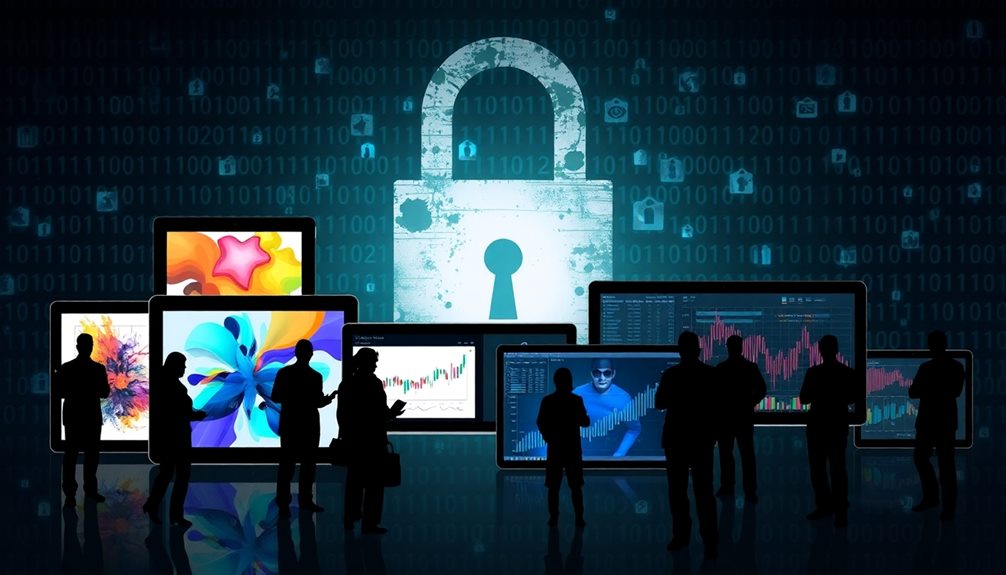
Data privacy issues are increasingly critical as art analysis tools become more prevalent. When you engage with these technologies, you often share sensitive information about your interactions, preferences, and personal data. If the platforms you use don't implement strong security measures, your information could be vulnerable to data breaches, exposing it to unauthorized access.
Additionally, many art analysis tools rely on cookies and tracking technologies, which can compromise your privacy by collecting data without your explicit consent. It's essential to be aware of how these tools manage your data and whether they comply with regulations like GDPR and CCPA, ensuring your data is handled ethically and transparently.
The integration of AI in these tools raises further concerns about ownership and usage rights of the processed data. You should look for clear policies regarding user consent and data management to protect your interests.
As you explore art analysis technologies, prioritize platforms that take data privacy seriously, providing robust security measures and obtaining your consent before collecting any information. Your awareness and vigilance can help safeguard your personal data in this evolving landscape.
Additional Resources

Exploring the world of art analysis can be greatly enhanced by leveraging a variety of resources tailored to different aspects of study. By using technology, you can access digital tools that significantly enrich your understanding of artworks.
For instance, digital image analysis tools like Adobe Photoshop and GIMP allow you to dissect color composition and brush strokes, revealing an artist's unique techniques.
Art history databases such as Google Arts & Culture and the Artstor Digital Library provide you with extensive collections of high-resolution images and scholarly articles. These resources facilitate in-depth research and analysis of various artworks.
Interactive art platforms like Smartify let you scan museum pieces, offering detailed information about the artists and historical context, which enhances your overall analysis experience.
Additionally, virtual reality applications, such as Oculus Medium, immerse you in three-dimensional environments, helping you explore spatial relationships and composition from new angles.
Collaborative analysis tools like Padlet encourage discussions among peers, allowing you to gather diverse insights on artistic elements and cultural significance.
Embracing these additional resources will undoubtedly deepen your appreciation and understanding of the art world.
Frequently Asked Questions
What Are Visual Arts Technological Tools?
Visual arts technological tools include software and applications that enhance creativity and streamline processes. You'll find programs for digital art creation, AI image generation, and platforms for collaboration, all enriching your artistic experience and analysis.
What Is the AI That Can Analyse Paintings?
AI that analyzes paintings uses deep learning algorithms to recognize styles and techniques. It evaluates composition, color palettes, and even detects forgeries by comparing brush strokes, giving you valuable insights into the artwork's context and authenticity.
What Is the AI Tool for Art?
AI tools for art let you create and manipulate images effortlessly. With platforms like ArtBreeder and DALL-E 2, you can explore new styles, generate unique artwork, and unleash your creativity without limits.
How Can Technology Be Used for Art?
You can use technology to explore art by utilizing image editing software, engaging with interactive applications, and participating in online platforms. These tools deepen your understanding, enhance creativity, and foster community discussions around artistic expression.
Conclusion
In conclusion, embracing technology tools for art analysis can truly enhance your understanding and appreciation of artworks. By leveraging AI and other essential tools, you can uncover deeper insights and refine your critiques. Remember to follow best practices and stay mindful of data privacy concerns as you explore these innovations. With the right approach, you'll not only enrich your own experience but also contribute to the evolving conversation around art in the digital age.
